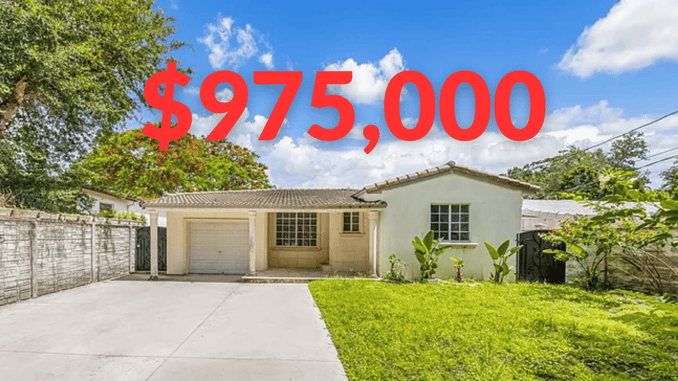Is this the Most Unaffordable Housing Market Thanks to Mortgage Rates?
 Author: Michael Bernstein
Author: Michael BernsteinPublished:
For generations, buying a home was the cornerstone of the American Dream. It wasn’t just about having a place to live — it was about building wealth, planting roots, and creating a legacy for future generations. Homeownership offered families stability, a sense of pride, and a path to long-term financial security. Communities thrived as neighbors became invested in one another, and home equity became one of the most reliable ways to grow personal wealth in America.
But in 2025, the reality is starkly different. Across the U.S.—including here in Texas—homebuyers face an unprecedented challenge: the most unaffordable housing market in history. The overhang from the pandemic, which includes historic price surges, soaring mortgage rates, stagnant wage growth, and tight housing supply, have combined to lock millions out of homeownership. For many, the dream of owning a home now feels more distant than ever before, but it doesn't have to be.
In this article, we’ll break down:
- Why mortgage rates have magnified affordability challenges like never before
- How home prices have soared past income growth and what that means for Texas families
- What makes 2025’s market different from past housing bubbles, including 2006
- What Texas homebuyers need to know now to navigate this tough market and still succeed

Zillow listing in Miami for $975,000
What Does Affordability Mean in Housing?
Housing affordability measures the relationship between household income and the cost of buying a home. Traditionally, this was viewed through the lens of the price-to-income ratio — with historically, a home costing about three times annual household income considered reasonably affordable. This standard held for much of the 20th century and offered a benchmark for sustainable homeownership that allowed families to build equity without overextending financially.
Over the decades, affordability also came to be tracked by indexes like the National Association of REALTORS® Housing Affordability Index (HAI). The HAI assumes a 20% down payment and calculates whether a median-income household earns enough to qualify for a median-priced home at prevailing mortgage rates. A value of 100 means the median income exactly qualifies; higher values mean greater affordability. Throughout the 1990s and early 2000s, this index often exceeded 120 or 130 nationally, signaling a relatively accessible market.
In 2025, however, the affordability picture looks far bleaker. The HAI now hovers just above 100 nationally, and the price-to-income ratio has soared well past 5:1 in many major metros, including Texas cities like Austin and Dallas. This growing imbalance forces buyers to stretch their budgets, delay purchases, or look farther afield for affordable options. It’s a stark shift from historical norms — one that reshapes the path to homeownership for middle-income families
U.S. Home Prices Have Reached Uncharted Territory
Inflation-adjusted home prices in 2025 have shattered records. According to the Case-Shiller Index, U.S. home values are now nearly 300% above their 1890 benchmark, far surpassing the 2006 housing bubble peak.

Despite some regional pullbacks (like in Austin), national home prices have continued to climb over the long term, driven by persistent demand, tight housing supply in key markets, and rising construction costs. Even with higher mortgage rates dampening affordability, prices have proven resilient, with many analysts noting that inflation-adjusted home prices in 2025 remain at or near record highs in most parts of the country.
In Texas, the trend is just as striking:
- Austin home prices have surged more than 50% since 2020, driven by tech-sector migration, limited supply, and a surge in cash buyers. Austin remains one of the most competitive housing markets in the nation—and there are signs prices could still climb as demand stays strong.
- Houston’s market has seen rapid appreciation fueled by energy-sector stability, population growth, and investor demand. How rising home prices and still tight supply are creating barriers, but there are opportunities that exist in emerging neighborhoods.
- Dallas home prices have also climbed, but buyers in 2025 are finding renewed leverage in some neighborhoods. This shifting market dynamics is creating new possibilities in Dallas.
Is there room for prices to go even higher? Maybe but Maybe not!
While today’s home prices remain historically high, the outlook is mixed. Experts highlight that:
- Inventory in Texas remains below what’s needed for a balanced market, even with recent (and dramatic) growth.
- Nationally, inventory has climbed about 33% over last year—reaching pre-pandemic levels in many regions—but this still isn’t enough to spark major price declines.
- Demand from out-of-state buyers continues, especially in metro areas like Austin, Dallas, and Houston.
- Builders face ongoing challenges including land costs, labor shortages, and regulatory hurdles that limit new supply.
Sun Belt markets like Austin have already seen significant price corrections since their peaks, and there may still be room for prices to fall slightly further. Many sellers are turning to incentives such as seller-paid closing costs and temporary rate buydowns rather than lowering asking prices outright, as we highlight in our article Seller Concessions vs Price Reductions. This strategy can mask underlying price softness and keep headline prices higher than what buyers are effectively paying. While a major crash is unlikely, gradual price adjustments or more widespread use of concessions could provide relief for buyers in the coming months.
Wages Can’t Keep Up With Soaring Home Prices
Over the past 10 years:
- 📈 National home prices surged ~94%
- 💼 Average hourly earnings rose just ~45%

This growing gap means today’s Texas homebuyers must devote a significantly larger share of their income to mortgage payments than ever before. Even strong wage growth in industries like tech and energy hasn’t bridged the affordability divide. The issue is compounded by the fact that, as detailed by the Economic Policy Institute, wages for most American workers have stagnated when adjusted for inflation over the past several decades. While worker productivity has increased significantly, median compensation has failed to keep pace, meaning that households today have far less purchasing power relative to rising housing costs than in previous generations. The issue could be even more exacerbated as companies downsize headcount while increasing their reliance on artificial intelligence (AI).
In fact, for many families across Texas—whether in booming urban centers like Austin and Dallas or smaller cities—housing costs are outpacing household budgets at a rate not seen in decades. The gap between earnings and home prices has widened so much that traditional benchmarks for affordability, such as spending no more than 30% of income on housing, are increasingly unattainable. This trend is not only squeezing first-time buyers but also reshaping where and how people live, often forcing moves to outer suburbs or less desirable areas.
The disconnect between wages and housing costs is reshaping the path to homeownership, making it more difficult for first-time buyers and middle-income families to secure a place in the market. Without significant policy changes or a shift in wage growth trends, affordability challenges are likely to persist, keeping homeownership out of reach for many working families.
Mortgage Rates in 2025: The Double Whammy for Texas Homebuyers
Mortgage rates have soared in tandem with home prices:
- 🏦 In 2021, 30-year fixed rates averaged ~3%.
- 🏦 In 2025, rates hover around 7% or higher, depending on loan type.
A monthly payment on a $400,000 30-year fixed mortgage at 3% is $1,686 vs at 7% its $2,661! That’s nearly $1,000 more each month—and this is before property taxes, insurance, and HOA fees (which are often significant in Texas).
Mortgage rates in 2025 remain stubbornly high across the U.S., hovering between 6.5% and 7% for 30-year fixed loans. In Texas, 30-year rates average near 6.9%, while 15-year fixed rates are closer to 6.2%. Adjustable-rate mortgages (ARMs) offer slightly lower initial rates, around 6.3%, but come with future uncertainty. As we discuss in our piece ARMs Make a Comeback, these loans are gaining traction in 2025 because they provide homebuyers a way to lower their monthly payment up front, with the potential to refinance before rates reset. Many Texas buyers are using ARMs strategically, pairing them with shorter-term housing plans or budgeting for a future refinance if rates fall. While the Federal Reserve has cut rates several times since the peak, the cutting cycle hasn’t yet produced significant relief in mortgage rates, and while modest declines into the low 6% range are forecast for late 2025, affordability gains could be offset by renewed buyer demand.
For Texas homebuyers, this double whammy of high prices and high borrowing costs means borrowing power has shrunk dramatically compared to just a few years ago—sometimes by more than $200,000. Many buyers are now exploring alternatives like ARMs, smaller down payments, or purchasing in lower-cost markets, aiming to refinance in the future when rates drop. Looking ahead, most forecasts—including those from Fannie Mae—suggest mortgage rates are expected to stay somewhat elevated through 2025, with only modest declines anticipated. While rates could edge down into the low 6% range by year-end, major rate relief isn’t likely, and any significant dip could quickly reignite buyer demand, limiting affordability gains. This underscores the importance of strategic planning for buyers navigating the current market.
What Makes the 2025 Housing Bubble Different?
The 2025 housing bubble is distinct from past bubbles, especially the one that led to the 2008 financial crisis. In 2006, loose lending standards and speculative buying inflated home prices artificially. Today, the drivers of high prices are more structural, with limited supply, higher construction costs, and strong demand playing a central role. There is less reliance on risky loans, but the outcome—an unaffordable market for many—feels familiar.
One major factor that sets 2025 apart is the prevalence of locked-in low-rate mortgages. Over 54% of U.S. mortgage holders still have rates below 4%, and in Texas this figure is even higher due to the refinancing boom of 2020-2021. These homeowners are reluctant to give up their low payments, keeping inventory tight and limiting options for move-up buyers.
Supply constraints unique to Texas have historically added pressure to home prices. Once celebrated for its affordability, Texas has faced zoning restrictions, rising land prices, and labor shortages that have hindered builders’ ability to keep up with demand, especially as rapid population growth in cities like Austin, Dallas, and Houston intensified these challenges. However, the picture is shifting in 2025.
Recent sales data for the Austin-Round Rock metro area shows that supply is on the rise: active listings are up 17.4% year-over-year, new listings increased by nearly 9%, and months of inventory climbed to 5.0. This indicates that while longer-term constraints remain, short-term supply pressures are easing somewhat as more homes come to market. The result is a more nuanced environment where supply challenges coexist with growing inventory, and this balance could start to put downward pressure on prices as 2025 progresses.
Unlike during the last housing bubble, today’s buyers tend to be better qualified. However, the cost burden is far greater. The combined expense of principal, interest, taxes, and insurance now claims a record share of household income. In Austin, for example, median-income families must allocate over 50% of their earnings to afford the median-priced home.
Finally, another difference lies in the persistence of high borrowing costs. Even though risky subprime lending is largely absent, elevated mortgage rates have reduced affordability just as dramatically. Together, these factors create a housing bubble that looks different in cause but similar in its harsh impact on aspiring homeowners.
What Texas Buyers Can Do Right Now
✅ Get pre-approved early: Understand exactly what you can afford before falling in love with a home.
✅ Work with a mortgage broker: Brokers often access better rates and more flexible programs than banks.
✅ Use mortgage calculators: Estimate your payment under various rate scenarios.
✅ Stay informed: Track mortgage rates, understand the market trends, housing supply trends, and builder incentives in your target area.
Final Thoughts: Finding Hope in a Challenging Market
While 2025 has posed unprecedented challenges for Texas homebuyers, there are still reasons for optimism. Inventory is gradually improving in key markets like Austin and Dallas, mortgage innovations such as ARMs are offering flexible solutions, and sellers are increasingly open to concessions that can help buyers manage costs. By staying informed, planning strategically, and working with trusted professionals, today’s buyers can position themselves to succeed—even in a tough housing landscape. The path to homeownership may be harder, but it’s far from impossible.
Want to find out how you can win in this market? We'd love to help you. Give us a call at 512.881.5099 or get in touch with me by completing this quick form, and I'll reach out as soon as possible.

About the Author:
Michael Bernstein